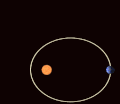apsidal precession (or apsidal advance) is the precession (gradual rotation) of the line connecting the apsides (line of apsides) of an astronomical body's...
17 KB (1,816 words) - 11:09, 2 October 2024
Precession (redirect from Astronomical precession)
the apsidal precession of Mercury In astronomy, precession refers to any of several gravity-induced, slow and continuous changes in an astronomical body's...
21 KB (2,718 words) - 21:49, 5 October 2024
Lunar precession (redirect from Lunar apsidal precession)
axial precession is westwards - whereas Apsidal precession is in the same direction as the rotation (meaning apsidal precession is eastward). This kind of...
7 KB (686 words) - 20:54, 29 October 2024
Milankovitch cycles (redirect from Astronomical theory of paleoclimates)
rotates (apsidal precession). The combined effect of precession with eccentricity is that proximity to the Sun occurs during different astronomical seasons...
50 KB (5,306 words) - 02:17, 14 November 2024
Lunar month (redirect from Astronomical month)
extreme points (the line of the apsides: perigee and apogee), rotates once (apsidal precession) in about 3,233 days (8.85 years). It takes the Moon longer...
24 KB (3,013 words) - 12:16, 31 December 2024
Costa, V. (December 1980). "Y CYG : photometry and apsidal motion". Publications of the Astronomical Society of the Pacific. 92: 782–784. Bibcode:1980PASP...
7 KB (493 words) - 10:41, 23 July 2024
if the geometry were favorable) is equal to the time of its periastron. Apsidal precession Kepler orbit Orbital mechanics Orbital node Iglesias-Marzoa...
4 KB (565 words) - 00:23, 24 September 2024
Planet Nine (category Astronomical events of the Solar System)
Raúl (2016). "Finding Planet Nine: Apsidal Anti-Alignment Monte Carlo Results". Monthly Notices of the Royal Astronomical Society. 462 (2): 1972–1977. arXiv:1607...
182 KB (19,427 words) - 03:18, 1 January 2025
Milan Cathedral (section Astronomical observations)
transepts have aisles. The nave columns are 24.5 metres (80 ft) high, and the apsidal windows are 20.7 by 8.5 metres (68 by 28 ft). It is a brick building, faced...
39 KB (4,655 words) - 09:17, 20 November 2024
Carina Nebula (category Astronomical objects discovered in 1752)
star HD 93205 by application of the theory of apsidal motion". Monthly Notices of the Royal Astronomical Society. 330 (2): 435–442. arXiv:astro-ph/0110662...
36 KB (3,723 words) - 19:37, 4 August 2024
Mimas (category Astronomical objects discovered in 1789)
mean diameter of 396.4 kilometres or 246.3 miles, Mimas is the smallest astronomical body known to be roughly rounded in shape due to its own gravity. Mimas's...
27 KB (2,621 words) - 17:01, 17 November 2024
Alexis Clairaut (section Focus on astronomical motion)
three-body problem, being the first to obtain a satisfactory result for the apsidal precession of the Moon's orbit. In mathematics he is also credited with...
17 KB (2,004 words) - 07:09, 21 August 2024
magnetic field Astronomical precession Axial precession or precession of the equinoxes, the precession of the Earth's axis of rotation Apsidal precession...
2 KB (319 words) - 17:28, 4 July 2024
Alessandro (2017). "Dynamical Evolution Induced by Planet Nine". The Astronomical Journal. 154 (6): 229. arXiv:1710.01804. Bibcode:2017AJ....154..229B...
38 KB (4,293 words) - 10:55, 22 December 2024
Planetary objects proposed in religion, astrology, ufology and pseudoscience (redirect from Hypothetical astronomical object (non-scientific))
10 months for this point to complete a circuit through the zodiac tracking the apsidal precession. L. Ron Hubbard, the founder of Scientology, proposed as part...
25 KB (3,171 words) - 05:19, 27 December 2024
time scale axial precession of Earth (with a 26,000 years cycle), while apsidal precession and other mechanics have a much smaller impact on sidereal observation...
10 KB (1,204 words) - 23:17, 28 December 2024
from now). Astronomical nutation Axial tilt Euler angles Longitude of vernal equinox Milankovitch cycles Polar motion Sidereal year Apsidal precession...
61 KB (8,341 words) - 01:24, 13 November 2024
corresponding movement of the position of the stars as seen from Earth, called the apsidal precession. (This is closely related to the precession of the axes.) The...
42 KB (3,906 words) - 14:59, 3 November 2024
and consists of a 13th-century choir, with an apse and seven polygonal apsidal chapels reached by an ambulatory, joined to a 16th-century transept. It...
17 KB (1,723 words) - 21:16, 8 December 2024
Newton applied his theorem to understanding the overall rotation of orbits (apsidal precession, Figure 3) that is observed for the Moon and planets. The term...
57 KB (7,566 words) - 14:07, 2 November 2024
ellipse of the orbit gradually rotates (among other possible effects). This apsidal precession is observed for all the planets orbiting the Sun, primarily...
47 KB (6,692 words) - 18:56, 25 September 2024
"The binary system 57 Cygni - apsidal motion and effects of spectral line blending", Monthly Notices of the Royal Astronomical Society, 164 (2): 101–110,...
8 KB (462 words) - 12:10, 17 July 2024
S/2018 J 4 (category Astronomical objects discovered in 2018)
its argument of pericenter oscillates about a constant value without apsidally precessing. For example, the Lidov–Kozai resonance causes Carpo's eccentricity...
6 KB (427 words) - 14:50, 24 February 2024
In astrodynamics, the orbital eccentricity of an astronomical object is a dimensionless parameter that determines the amount by which its orbit around...
25 KB (2,771 words) - 08:25, 1 January 2025
fixed in space but rotates over time. This orbital precession is called apsidal precession and is the rotation of the Moon's orbit within the orbital plane...
37 KB (4,643 words) - 05:36, 1 January 2025
Mercury (planet) (category Astronomical objects known since antiquity)
the planet with Apollo instead, as detailed by Pliny the Elder. The astronomical symbol for Mercury is a stylized version of Hermes' caduceus; a Christian...
155 KB (15,927 words) - 20:20, 5 December 2024
S/2023 U 1 (category Astronomical objects discovered in 2023)
nodal precession with an average period of about 5,000 Earth years and apsidal precession with an average period of about 5,100 Earth years. S/2023 U...
12 KB (1,128 words) - 00:01, 6 December 2024
sequence. Their orbit is somewhat eccentric (e=0.15) and the period of apsidal precession is 102 years. "MAST: Barbara A. Mikulski Archive for Space Telescopes"...
7 KB (514 words) - 00:29, 23 August 2024
George William Hill (category Recipients of the Gold Medal of the Royal Astronomical Society)
provided the first complete mathematical solution to the problem of the apsidal precession of the Moon's orbit around the Earth, a difficult problem in...
11 KB (1,083 words) - 09:01, 13 September 2024
of the orbital plane of a satellite around the rotational axis of an astronomical body such as Earth. This precession is due to the non-spherical nature...
6 KB (905 words) - 04:52, 26 July 2024




















